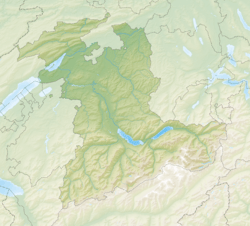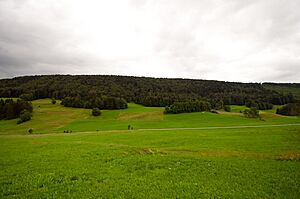Monible facts for kids
Quick facts for kids
Monible
|
||
|---|---|---|
|
||
| Country | Switzerland | |
| Canton | Bern | |
| District | Jura bernois | |
| Area | ||
| • Total | 3.39 km2 (1.31 sq mi) | |
| Elevation | 862 m (2,828 ft) | |
| Population
(Dec 2011)
|
||
| • Total | 37 | |
| • Density | 10.91/km2 (28.3/sq mi) | |
| Postal code |
2715
|
|
| Surrounded by | Rebévelier, Châtelat, Sornetan, Undervelier | |
Monible was a small town, also called a municipality, in the Jura bernois area of the canton of Bern in Switzerland. It was located in the part of Bern where people speak French. On January 1, 2015, Monible joined with three other towns: Châtelat, Sornetan, and Souboz. Together, they formed a new municipality called Petit-Val.
Contents
History of Monible
Monible was first mentioned in a document from 1403. However, this document was actually written in 1414. Later, in 1537, it was clearly called Monible.
For a long time, Monible was part of the Amt of Sornetan. An Amt was like a local government area. This area was controlled by the provost of Moutier-Grandval Abbey. A provost was a religious leader who also had political power. This provost was under the Prince-Bishop of Basel, another powerful religious and political leader.
In 1743, a big fire destroyed most of the village. After the French invaded Switzerland in 1798, Monible became part of a French region called Mont-Terrible. A few years later, in 1800, it became part of another French region called Haut-Rhin. After Napoleon was defeated, Monible was given to the Canton of Bern in 1815. This happened during a big meeting called the Congress of Vienna.
Since the 1800s, the number of people living in Monible has slowly gone down. In 1956, the main primary school in the town closed. Today, only a kindergarten is still open for young children.
Geography of Monible
Before it merged, Monible covered an area of about 3.4 square kilometers (1.3 square miles). A large part of this land, about 48.7%, was used for farming. Another big part, about 47.8%, was covered by forests.
A small amount of land, about 1.5%, had buildings or roads on it. A tiny bit, 0.9%, was unproductive land, meaning it couldn't be used for farming or building. Most of the forest was dense, covering 43.4% of the total land. Some areas also had orchards or small groups of trees. For farming, 36.0% of the land was used for pastures, where animals graze. Another 11.2% was used for alpine pastures, often in higher areas.
Monible is a small hamlet, which means it's a very small village. It is located on a hill not far from Sornetan. On December 31, 2009, the old district of Moutier, which Monible was part of, was closed. The next day, Monible joined a new administrative district called Jura bernois.
Monible's Coat of Arms
The blazon of Monible's coat of arms describes its design. A blazon is a special way to describe a coat of arms using specific words. Monible's coat of arms shows a silver background. On it, there is a blue pigeon holding a red horseshoe in its beak. This pigeon stands on a green hill.
People in Monible (Demographics)
In 2013, Monible had a population of 36 people. Over the ten years before that (from 2001 to 2011), the population decreased by about 14%. More people moved away than moved in, and there were slightly more births than deaths.
Most people in Monible speak French. In 2000, 31 people (88.6%) spoke French as their main language. The rest spoke German.
In 2008, a little more than half the population (53.5%) was male, and 46.5% was female. Most people living in Monible were Swiss citizens.
The population of Monible is made up of different age groups. In 2011, children and teenagers (ages 0-19) made up 27% of the population. Adults (ages 20-64) were the largest group at 56.8%. Seniors (over 64 years old) made up 16.2%.
In 2000, there were 13 single people in Monible who had never been married. There were 20 married people, 1 widow or widower, and 1 divorced person.
In 2010, there were 3 households with only one person living in them. There were also 2 households with five or more people. Most apartments in Monible were lived in all the time. In 2011, more than half of the homes were single-family houses.
The chart below shows how Monible's population has changed over many years:

Important Historical Sites
The Forêts du Beucle is a very old iron mine from the Middle Ages. This site is considered a heritage site of national significance in Switzerland. This means it is a very important historical place that is protected.
Economy in Monible
In 2011, the unemployment rate in Monible was very low, at 0.96%. This means almost everyone who wanted a job had one. In 2008, 15 people worked in the town. Most of them (13 people) worked in the primary economic sector. This sector includes jobs like farming and forestry. There were 3 businesses in this area.
No one worked in the secondary sector, which includes manufacturing and construction. Only 2 people worked in the tertiary sector, which includes services like shops and offices. There were 2 businesses in this sector.
In 2008, there were 10 full-time jobs in Monible. Eight of these jobs were in agriculture. The other two jobs were in the service industry, like sales or information services.
Many people who lived in Monible worked outside the town. In 2000, 13 workers traveled out of Monible for their jobs, while only 3 workers came into Monible to work. This means Monible was a "net exporter" of workers. Most workers (80%) who lived in Monible also worked there. About 4% of workers used public transportation, and 52% used a private car to get to work.
People in Monible paid taxes to their local government and the canton. In 2011, a married person with two children earning 150,000 CHF paid about 13% in taxes. An unmarried person paid about 19.1%. These rates were a bit lower than the average for the whole canton of Bern.
Religion in Monible
Based on information from the 2000 census, most people in Monible belonged to the Swiss Reformed Church. About 88.6% of the population (31 people) were part of this church. A smaller group, 3 people (8.6%), were Roman Catholic. One person did not belong to any church and was either agnostic or atheist.
Education in Monible
In Monible, about 44.4% of the people had finished upper secondary education. This is schooling after primary school that is not always required. Also, 18.5% had completed higher education, like going to a university.
The school system in the Canton of Bern starts with one year of optional Kindergarten. After that, children go to Primary school for six years. Then, they attend three years of lower Secondary school. In secondary school, students are grouped based on their abilities. After lower Secondary, students can choose to continue their schooling or start an apprenticeship, which is like on-the-job training.
During the 2011-2012 school year, 15 students attended classes in Monible. There was one kindergarten class with all 15 students. Some of these kindergarten students (13.3%) spoke a different language at home than the language used in the classroom.
In 2000, 6 students attended school in Monible, and all of them came from other towns. In the same year, one person who lived in Monible went to school outside the town.
See also
 In Spanish: Monible para niños
In Spanish: Monible para niños





